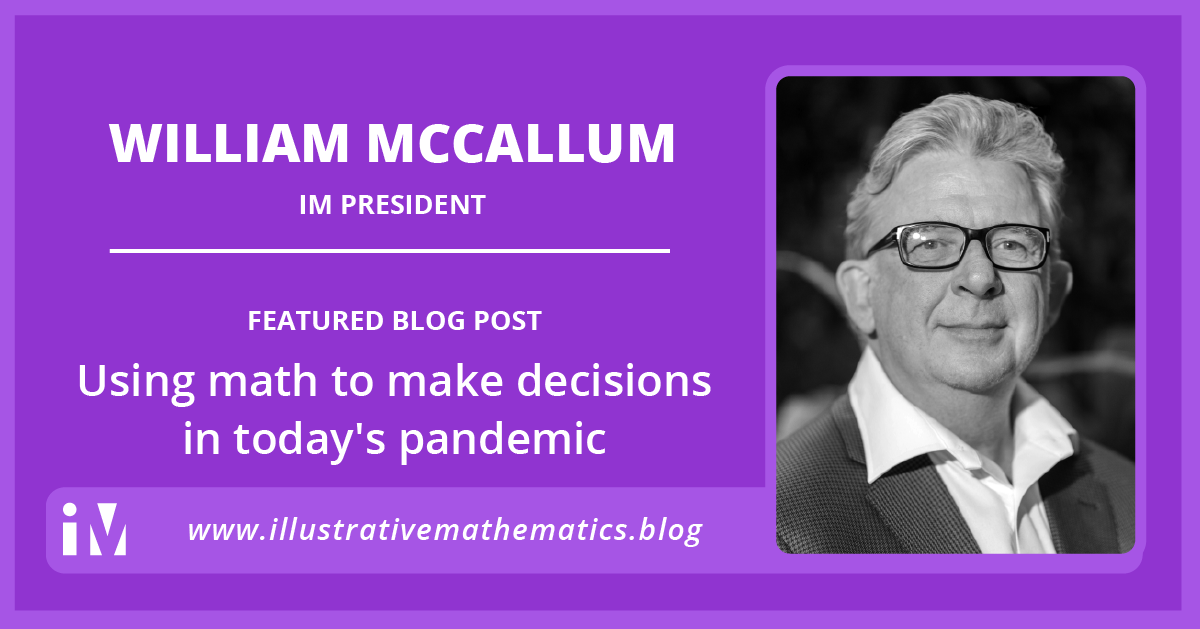By William McCallum
At Illustrative Mathematics, our mission is to create a world where all learners know, use, and enjoy mathematics. This is not just an idle wish, one that we have because we love mathematics. Sometimes knowledge of mathematics translates directly into power to do good.
Everybody is worried about COVID-19. Some of those worries are personal: What is my risk? Will I get infected? Should I stay home? I’m not going to address those worries in this blog post. They are personal and must be decided by everybody individually. Mathematics can help you assess the risk, but it is up to you to decide what to do in response. My only advice is to avoid both false reassurance and unreasoned panic.
However, there is another aspect to this pandemic. What can we do together, as a community, as a society, to ensure the best outcome for all? This is not about personal worry but about community action. It is about taking steps that might not be of individual significance but that, taken collectively, can save lives. Mathematics can help here too, and I want to explain how.
As mathematicians, we understand exponential growth. In the initial stages of an epidemic, cases grow exponentially. That’s shown in the initial part of the curves below, where the curve keeps getting steeper and steeper. We understand that with exponential growth, everything looks fine until it doesn’t. Of course, exponential growth doesn’t continue indefinitely. Eventually new, uninfected hosts are less and less available to the virus and the epidemic dies down. The progress of the virus looks like one of these curves.

One of them swamps the healthcare system, the other doesn’t. More people die in the first one because some sick people are unable to get the care they need, so how can we make the second one happen?
There have been lots of recommendations on that: washing hands, not touching your face, social distancing, avoiding large meetings. I want to focus on the last one because I think it’s an area where we mathematicians can do a little bit of modeling with vivid results. Here is the model I’d like to propose, let’s call it the handshake model. Suppose that, say, 10 people meet and all shake hands. How many handshakes are there? Each of the 10 people shakes hands with 9 other people, so that’s 90 handshakes. Except that we just counted each handshake twice, once for each person, so really it’s only 45 handshakes. The same reasoning shows that in a meeting of n people, if everybody shakes hands, there are n(n-1)/2 handshakes.
Of course, with COVID-19, we shouldn’t be shaking hands at all. Still, in a meeting of n people it seems reasonable to suppose that being present in the meeting is like shaking hands with everybody there. If you are at a meeting with n people you are sharing space with them in close proximity. Being close to someone is analogous to a handshake. Not everybody who is at the meeting will arrive infected, but the probability that someone does arrive infected grows in proportion to the size of the meeting, as illustrated in the graphic below.

And once there is someone at the meeting who is infected, the handshake model suggests that the number of transmissions grows with the square of the size of the meeting. I won’t go into the details, but in the initial stages of an epidemic, when the proportion of infected is small, the number of transmissions is approximately proportional to the number of handshakes (geek alert—this is fun to work out). And when the meeting is large, the number of handshakes is approximately proportional to the square of the size of the meeting.
This means that a meeting of 1,000 people will have transmissions proportional to 1,000^2 = 1,000,000, whereas a meeting of 30 people will have transmissions proportional to 30^2, or about 1,000. The big meeting has 1,000 times more transmissions than the small one. Another way of thinking about it is that a meeting that is 10 times as large will have 10^2 = 100 times as many transmissions. If we want to flatten the curve, we need to slow the number of transmissions that occur every day, because the daily transmission rate determines how steep the initial, exponential growth part of the curve is. The simple step of avoiding large meetings is a huge step in this direction, because of the quadratic nature of the dependence between the transmission rate and the size of the meeting.
Like any model, the handshake model is only an approximation to the truth, which is probably much more complicated. But I think that the underlying implication of the model—that large meetings are not only worse than small meetings, but much worse—is highly plausible, especially since it agrees with what public health officials are recommending. Minimizing large gatherings will help flatten the curve. As mathematicians, we understand exponential growth, and we understand quadratic relationships. Let’s use that understanding to save lives.
